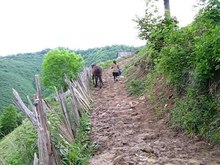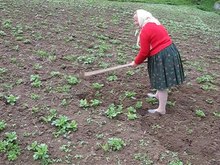Obcina (Maramureș)
Obcina ( Ukrainian : "up on the mountain") is a Ruthenian hilltop settlement at about 1000 m above sea level on a pass, belonging to the municipality of Poienile de sub Munte in the Romanian district of Maramureș in northern Romania . In this hamlet with no access road, there is still a high level of self-catering that is otherwise difficult to find in the EU. The life of the farmers without machines, without electricity and vehicles became known nationwide, especially through the documentary "Obcina" by the Berlin artist Björn Reinhardt.
The settlement can only be reached on foot from Poienile de sub Munte in the Valea Misica valley or from Vișeu de Mijloc ( Mittelwischau ) via the Valea Vinului valley. Due to its geographical remoteness and the poverty of the residents, there is still no road directly to Obcina. The settlement has been surrounded by a network of animal trails, shepherds' and transport routes since ancient times. The residents neither expand nor maintain the paths. The few products that are suitable for sale, such as self-made sheep's cheese and blueberries, raspberries or mushrooms collected in the surrounding forests, are carried away with the rucksack. In steep terrain, wood is pulled directly down to the valley by horse. If it's shallower, a sleigh is used. Sledges are also used to transport the hay to the characteristic barns and to the barns. The hay stores are only brought into the valley in horse-drawn sleighs in winter after the first snowfall. The necessary work and food are supplied via a backpack from Poienile. Apart from a few devices such as radio or cell phone with a battery, there are no electric devices.
Characteristic of the area are the dense deciduous forests of the Forest Carpathians , which are part of the Pietrosul Maramureșului group. The view to the northwest shows the massif of Pop Iwan ( Vârful Pop Ivan 1937 m), to the north the Farcau ( Vârful Farcău 1956 m), to the northeast the Vârful Rechita (1573 m) and to the south to the mountains around the Wischau valley . There are no other scattered settlements at a similar altitude.
The alpine village, consisting of ten small farms, was still inhabited by eight Ruthenian families, mostly with many children, from spring to autumn around 2009. The Ruthenians are a Ukrainian minority in northern Romania , whose language and culture have largely been preserved. While dozens of people work here in the summer, all the residents except one family move into their houses in the valley during the winter.
In contrast to other villages without an access road, such as the northern Italian mountain villages Moggessa di Quà , Moggessa di Là and Stavoli , Obcina is , however, much more original. The cultural landscape is still very much shaped by human handicraft. Meadows that grow again are still rare.
Maramureș Film Archive
The mountain settlement gained a certain fame through the documentary filmmaker Björn Reinhardt, who lives in the neighboring Valea Vinului. In the “Maramureș Filmarchiv” series, Reinhardt, who speaks Romanian himself, documents life in the Maramureș with ethnographic meticulousness and great empathy. In the meantime eight documentaries have been released in the series. Two of them are explicitly dedicated to the village, "Obcina" (2006) and "der kinderberg" (2009).
"Obcina - The most spectacular mountain settlement of the Maramureș" is the first part of the "Ruthenian Trilogy". The film follows the life of the family of the cooper Ștefan Cut over the course of the year. His family is the last to stay in Obcina even in the harsh winter. It is important to defend your own animals including the dog against the hungry wolves and to get by with the few self-produced foods such as buried potatoes. The usual life on the farm is threatened when Ștefan's workforce suffers more and more from a frozen finger and no improvement is in sight. The farmer is very afraid of the pain and costs of the operation. The film also portrays work and life in summer, the residents making music or the life of large families. The film has won several awards. Ștefan Cut has since passed away.
The second part of the Ruthenian trilogy shows the “shockingly beautiful childhood” in Obcina. It is about the lives of the many children in the field of tension between a carefree growing up in nature on the one hand, but also the arduous life in the mountains, the work that is also required of the children, or the absence of parents on the other side.
swell
- ↑ Björn Reinhardt / www.maramures.de: Orientierungshilfe , accessed on February 25, 2010
- ↑ Maramures Filmarchiv , accessed on March 18, 2020



